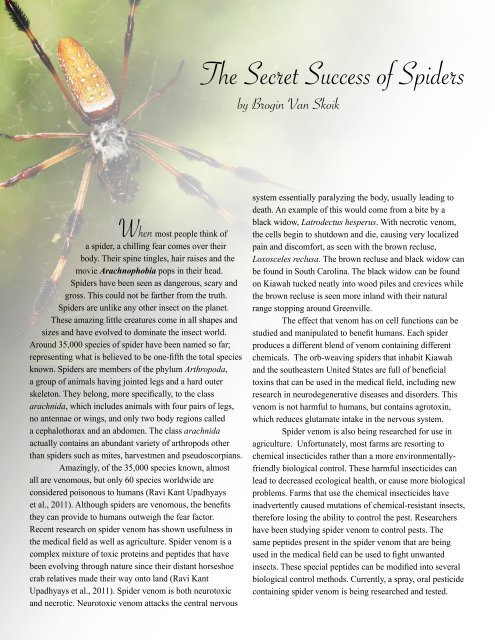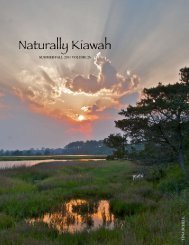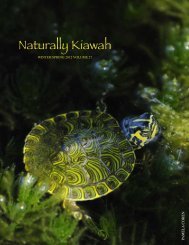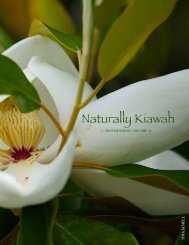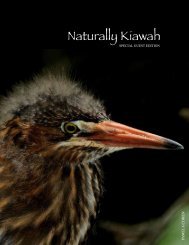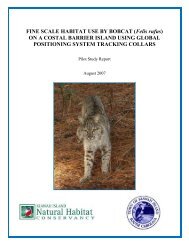The Secret Success of Spiders - Kiawah Conservancy
The Secret Success of Spiders - Kiawah Conservancy
The Secret Success of Spiders - Kiawah Conservancy
You also want an ePaper? Increase the reach of your titles
YUMPU automatically turns print PDFs into web optimized ePapers that Google loves.
<strong>The</strong> <strong>Secret</strong> <strong>Success</strong> <strong>of</strong> <strong>Spiders</strong>by Brogin Van SkoikWhen most people think <strong>of</strong>a spider, a chilling fear comes over theirbody. <strong>The</strong>ir spine tingles, hair raises and themovie Arachnophobia pops in their head.<strong>Spiders</strong> have been seen as dangerous, scary andgross. This could not be farther from the truth.<strong>Spiders</strong> are unlike any other insect on the planet.<strong>The</strong>se amazing little creatures come in all shapes andsizes and have evolved to dominate the insect world.Around 35,000 species <strong>of</strong> spider have been named so far;representing what is believed to be one-fifth the total speciesknown. <strong>Spiders</strong> are members <strong>of</strong> the phylum Arthropoda,a group <strong>of</strong> animals having jointed legs and a hard outerskeleton. <strong>The</strong>y belong, more specifically, to the classarachnida, which includes animals with four pairs <strong>of</strong> legs,no antennae or wings, and only two body regions calleda cephalothorax and an abdomen. <strong>The</strong> class arachnidaactually contains an abundant variety <strong>of</strong> arthropods otherthan spiders such as mites, harvestmen and pseudoscorpians.Amazingly, <strong>of</strong> the 35,000 species known, almostall are venomous, but only 60 species worldwide areconsidered poisonous to humans (Ravi Kant Upadhyayset al., 2011). Although spiders are venomous, the benefitsthey can provide to humans outweigh the fear factor.Recent research on spider venom has shown usefulness inthe medical field as well as agriculture. Spider venom is acomplex mixture <strong>of</strong> toxic proteins and peptides that havebeen evolving through nature since their distant horseshoecrab relatives made their way onto land (Ravi KantUpadhyays et al., 2011). Spider venom is both neurotoxicand necrotic. Neurotoxic venom attacks the central nervoussystem essentially paralyzing the body, usually leading todeath. An example <strong>of</strong> this would come from a bite by ablack widow, Latrodectus hesperus. With necrotic venom,the cells begin to shutdown and die, causing very localizedpain and discomfort, as seen with the brown recluse,Loxosceles reclusa. <strong>The</strong> brown recluse and black widow canbe found in South Carolina. <strong>The</strong> black widow can be foundon <strong>Kiawah</strong> tucked neatly into wood piles and crevices whilethe brown recluse is seen more inland with their naturalrange stopping around Greenville.<strong>The</strong> effect that venom has on cell functions can bestudied and manipulated to benefit humans. Each spiderproduces a different blend <strong>of</strong> venom containing differentchemicals. <strong>The</strong> orb-weaving spiders that inhabit <strong>Kiawah</strong>and the southeastern United States are full <strong>of</strong> beneficialtoxins that can be used in the medical field, including newresearch in neurodegenerative diseases and disorders. Thisvenom is not harmful to humans, but contains agrotoxin,which reduces glutamate intake in the nervous system.Spider venom is also being researched for use inagriculture. Unfortunately, most farms are resorting tochemical insecticides rather than a more environmentallyfriendlybiological control. <strong>The</strong>se harmful insecticides canlead to decreased ecological health, or cause more biologicalproblems. Farms that use the chemical insecticides haveinadvertently caused mutations <strong>of</strong> chemical-resistant insects,therefore losing the ability to control the pest. Researchershave been studying spider venom to control pests. <strong>The</strong>same peptides present in the spider venom that are beingused in the medical field can be used to fight unwantedinsects. <strong>The</strong>se special peptides can be modified into severalbiological control methods. Currently, a spray, oral pesticidecontaining spider venom is being researched and tested.
<strong>The</strong> SpiderWatch the busy spider,He's helpful as can be,Eating insects all day longNow they won't bite me.Author Unknown<strong>The</strong> ability to produce venom, which only themost complex organisms are able to accomplish, is trulya remarkable adaptation. In addition, spiders produceone <strong>of</strong> the strongest materials in the world. <strong>The</strong>ir silk is acomplex adaptation that allows the spider to manipulate itsenvironment and has been highly sought after for textilesthroughout history. To date, humans have been unable toartificially produce this silk, making arthropods the onlyorganism in the world that can (Cookson and Krafft, 2012).Almost all insects produce some sort <strong>of</strong> silk protein. Forinstance, worker ants have been known to sew leavestogether with silk containing larvae. <strong>The</strong> construction <strong>of</strong>a web can be highly complex and sophisticated which is areason why web building is very important to the survival<strong>of</strong> the spider. By building this three dimensional structurethe spider is able to manipulate its environment similar toan architect constructing a suspension bridge over a body <strong>of</strong>water.<strong>The</strong>se adaptations are highly complex behaviors notalways taken into consideration when observing these trulyamazing creatures. <strong>Spiders</strong> may be a lot different than otherorganisms in terms <strong>of</strong> look and appeal, but none-the-lessare just as important to the overall health <strong>of</strong> the planet andhumans.<strong>Spiders</strong> are an important part <strong>of</strong> the ecosystempreying on the occasional bird or mammal and all insectscommon around houses. <strong>The</strong>ir contribution to controllinginsect populations in residential and natural areas is a keyingredient to the health <strong>of</strong> <strong>Kiawah</strong>’s fragile ecosystems. nWorks Cited:Krafft, B., Cookson, L. 2012. <strong>The</strong> Role <strong>of</strong> Silk in the Behavior and Sociality <strong>of</strong> <strong>Spiders</strong>, Article ID 529564, 25 pages.Upadhyay, R. et al, 2011. A Review on Spider Toxins a Useful Source <strong>of</strong> Pharmacological Peptides, Journal <strong>of</strong> Pharmacy Research , 4(4), 1169-1172.Photographs courtesy <strong>of</strong> Pamela Cohen


